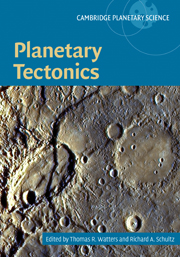Book contents
- Frontmatter
- Contents
- List of contributors
- Preface
- 1 Planetary tectonics: introduction
- 2 The tectonics of Mercury
- 3 Venus tectonics
- 4 Lunar tectonics
- 5 Mars tectonics
- 6 Tectonics of small bodies
- 7 Tectonics of the outer planet satellites
- 8 Planetary structural mapping
- 9 Strength and deformation of planetary lithospheres
- 10 Fault populations
- Index
- Plates
Preface
Published online by Cambridge University Press: 30 March 2010
- Frontmatter
- Contents
- List of contributors
- Preface
- 1 Planetary tectonics: introduction
- 2 The tectonics of Mercury
- 3 Venus tectonics
- 4 Lunar tectonics
- 5 Mars tectonics
- 6 Tectonics of small bodies
- 7 Tectonics of the outer planet satellites
- 8 Planetary structural mapping
- 9 Strength and deformation of planetary lithospheres
- 10 Fault populations
- Index
- Plates
Summary
There are few periods in the history of science that compare to the explosion of knowledge from robotic and manned exploration of the bodies of our solar system over the last 50 years. In this golden age of planetary exploration, hundreds of thousands of detailed images of the terrestrial planets, the outer planets and their icy satellites, and many asteroids and comets have been obtained by manned and unmanned spacecraft. In the near future, spacecraft already in flight will complete surveys of our innermost planet, Mercury, and provide the first high-resolution images of outermost Pluto.
In the pursuit of understanding the origins and geologic evolution of the solid bodies in the solar system, many similarities and differences have emerged in the processes that shaped their landscapes. One of the most fundamental of these processes is tectonics. The number and diversity of tectonic landforms is truly remarkable. The investigation of these tectonic landforms has stimulated an equally diverse range of studies, from the characterization and modeling of individual classes of tectonic landforms to the assessment of regional and global tectonic systems. These investigations expose the complex interplay between the forces that act on planetary crusts, both internal and external, and the mechanical properties of crustal material.
Over the past several decades, planetary tectonics has become an important component at geoscience and planetary science meetings, conferences, and workshops worldwide.
- Type
- Chapter
- Information
- Planetary Tectonics , pp. xi - xiiPublisher: Cambridge University PressPrint publication year: 2009



